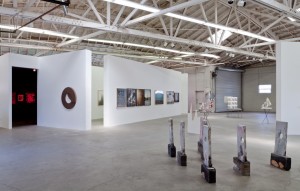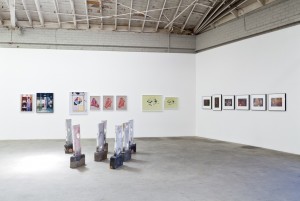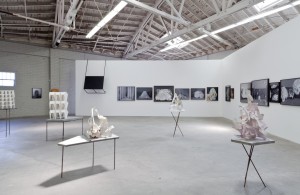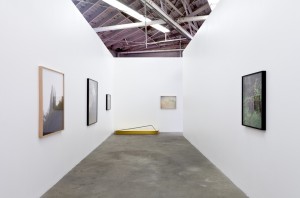While we’re all trying to tear ourselves away from LACMA (where the lush summer acreage of masterpiece exhibitions seems to hold us captive) for a last glimpse at our faves (or misses) in the Made in L.A. 2014 show at The Hammer (or maybe Elvis Costello at the Hollywood Bowl), this being L.A., there’s something new and exciting to see—yes, even in the world of fine art.
Or maybe not all new—but some of it; or some of it simply new to us. (I guess that means me.) Okay, so it’s a group show, which means that some of the juxtapositions, whether deliberate or inadvertent, might throw otherwise familiar work into a new light or perspective. And there are certainly a few old ‘chestnuts’ here. Well, one anyway—but, let’s just say, not what you might have expected.
And frankly I’m not sure what I would have been led to expect from Sterling Ruby, who has curated a show for Night Gallery, called Trains. The show is excellent; and I would encourage anyone venturing southeast of downtown to have a look. But I can’t predict what sense viewers will take from these various works in photography and sculpture, and their elegant yet skewed juxtapositions and arrangements, or what perspective on this curatorial ‘criss-cross’ they might come away with.
 I feel compelled to reproduce portions of Ruby’s slightly opaque (and very brief) curatorial statement, not for its explanatory power, but simply as a refraction that might help adjust the viewer’s focus on one or another aspect of the show. Make of this what you will:
I feel compelled to reproduce portions of Ruby’s slightly opaque (and very brief) curatorial statement, not for its explanatory power, but simply as a refraction that might help adjust the viewer’s focus on one or another aspect of the show. Make of this what you will:
“THE EXHIBITION WILL BE LAID OUT IN LINES. THE EXHIBITION WILL BE HUNG IN SEQUENCES BREAKING CHRONOLOGY. THE EXHIBITION WILL BE FORMAL, BUT NOT JUST SHAPES. PHOTOGRAPHY AND SCULPTURE ARE NOT THE SAME THING, BUT THEY ARE COMPANIONS. SOME CHOOSE MORE, SOME CHOOSE LESS, EVERYONE HAS TO HAVE AT LEAST TWO, AND THE BOUNDARIES ARE DERAILED.
: : :
“MOTIVE POWER, PULL YOUR WEIGHT, WHEN WILL THIS TRAIN EVER END, THE PASSENGERS, THE UNDERGROUND, BLOCKING THE VARNISH, NIGHT TRAIN EXPRESS, SPATIALLY SEPARATED IMAGES AND OBJECTS OCCUR AT THE SAME TIME BECOMING LINKED BY THE OBSERVER, TRAIN AND PLATFORM EXPERIMENTS, WHEN & WHERE EVENTS OCCUR WHEN YOU WERE NOT PRESENT, THE LOCOMOTIVE, THE CHAIN, THE CABOOSE, THE TROLLEY PROBLEM, THE O TRAIN, THE REAPER RIPS OVER THE TRACK AND NOW EVERYTHING IS COVERED IN PISS.”
(Did I mention the statement was all in caps?) Photography and sculpture. The emphatically two-dimensional versus the emphatically three-dimensional. But we can skip all that straightaway. The show steers clear of those sorts of fallacies—simply by way of the flowing layout of the gallery(ies), but also in the work itself. First of all, both categories imply a sculptural act; the placement of the hand and eye; sculptural values implicit in the images themselves; moreover, the notion of temporal displacement, real or implied movement. But the notions and values of placement/position, arrangement/array, configuration redound to the photographs themselves. 
The nexus between photography and sculpture in close proximity seemed especially pronounced between the parallel semiotics of Erik Frydenborg’s variously mounted and perforated ‘stele’ (dominoes? disintegrating giant USB drives? decayed grave markers?—I’m at a loss to give a shorthand description) and Annette Kelm’s cool, slightly bleached-looking photographs of variously folded/configured paisley kerchiefs or bandanas with their scatterings of grass or grain stalks (I Ching, anyone?); and the spatial, architectural and textural parallels between Sarah Conaway’s slightly surreal photographic dramas of volume, placement and scale (as well as texture) and Jeff Ono’s variously constructed/choreographed arrays and matrices. 
 And then came Thea Djordjadze. Climbing over one wall like a swinging trapeze or errant folding chair into the mise-en-scène. Little sister come to wreak havoc in big sister Sarah’s orderly set pieces (there’s even a sly echo of the construction in one of the photographs). Or (speaking of collapsing lawn furniture), tentatively triangulating its place/space amid the surreal gardens and landscapes of Melanie Schiff (here a domain of reflection rather than earthly pleasures)—cagily brilliant stuff with echoes of Caro, but its own original wit.
And then came Thea Djordjadze. Climbing over one wall like a swinging trapeze or errant folding chair into the mise-en-scène. Little sister come to wreak havoc in big sister Sarah’s orderly set pieces (there’s even a sly echo of the construction in one of the photographs). Or (speaking of collapsing lawn furniture), tentatively triangulating its place/space amid the surreal gardens and landscapes of Melanie Schiff (here a domain of reflection rather than earthly pleasures)—cagily brilliant stuff with echoes of Caro, but its own original wit.
 In Schiff’s photographs, the semiotic (or perhaps simply ‘informational’) and textural aspects seem a footnote to an implicit instability and uncertainty. These are worlds that seem to recede, regardless how ‘close’ or distant. Of course, proximity is an issue throughout the show, generally. But in these images, we have a sense of the nominal ‘subject’ foreshadowed (or backshadowed) by a liminal subject.
In Schiff’s photographs, the semiotic (or perhaps simply ‘informational’) and textural aspects seem a footnote to an implicit instability and uncertainty. These are worlds that seem to recede, regardless how ‘close’ or distant. Of course, proximity is an issue throughout the show, generally. But in these images, we have a sense of the nominal ‘subject’ foreshadowed (or backshadowed) by a liminal subject.
 That sense of suspension—also framing, containment—point to one of the show’s guiding spirits—the photographer, Nobuyoshi Araki, represented here by a selection of his color-saturated flower studies. If they seem less than characteristic, even out-of-step with the rest of the show, I would argue that the same ambiguities of shadow and reflection, liminal subject, and proximity (to, among other things, life and death) are in ebullient play here.
That sense of suspension—also framing, containment—point to one of the show’s guiding spirits—the photographer, Nobuyoshi Araki, represented here by a selection of his color-saturated flower studies. If they seem less than characteristic, even out-of-step with the rest of the show, I would argue that the same ambiguities of shadow and reflection, liminal subject, and proximity (to, among other things, life and death) are in ebullient play here.
“…[T]he reaper rips over the tracks….” I’m not sure what to make of Ruby’s statement, but – ‘criss-cross’ – we’re all just ‘strangers on a train’ here. As the viewer loops past the photographs and around the sculptural installations, we may have a similar sense of sensory (visual/sonic/mnemonic) decay not so dissimilar from the sonic wave decay of a train whistle as it hurtles full speed ahead—memory and reflection flying ahead of each fresh encounter sounding its own uniquely pitched shriek or whisper.
The other artists include Piero Golia, Augustus Thompson and Brenna Youngblood (all in very good form), as well as a collaborative series between Richard Hawkins and Marcel Alcalá, which seems a bit out of place here. And in case you’re wondering—yes, Melanie Schiff happens to be married to Sterling Ruby. I don’t really see a conflict here; Schiff’s work falls well within this curatorial compass. I suppose an argument could be made one way or the other about any of these decisions; but they were Sterling’s to make, and if you have a problem with it—as Joan Rivers might have put it—you can just go fuck yourself.


